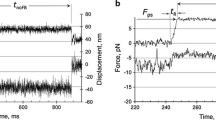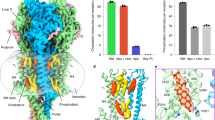Abstract
The goal of the study was to simulate twitch strength and neuromuscular block produced by nondepolarizing muscle relaxants. Methods: In the proposed model, affinities of the two binding sites at a single postsynaptic receptor for acetylcholine (A) and the muscle relaxant (D) define the formation of three complexes with A only, three complexes with D only, and two complexes with both A and D. Twitch strength was postulated to be a function of the receptors with both binding sites occupied by A, and two constants. Neuromuscular block (NMB) was calculated from NMB=1-twitch. Results: Stimulus-induced release of A results in rapid, but transient, changes in the concentrations of free A, the eight complexes, and the unoccupied receptors. Muscle relaxants that display either a congruous or an inverse pattern of affinities for the binding sites relative to those of A produce NMB vs. [D] curves with slightly different slopes but markedly different estimates for IC50. Depending on the number of activated receptors at the end plates of muscle fibers, the simulations represent the distributions of contracting fibers in a whole muscle. Conclusion: Simulations of competition between A and D for binding to two sites at a receptor reveal that the potencies of muscle relaxants, defined by IC50, and the slopes of the NMB vs. [D] curves depend on (1) the affinities of D for the two binding sites, (2) the orientation of the affinities relative to those of A, and (3) the affinities of A for the same two sites.
Similar content being viewed by others
REFERENCES
C. Hull, B. H. Van, K. McLeod, A. Sibbald, and M. Watson. A pharmacodynamic model for pancuronium. Br. J. Anaesth. 50:1113-1123 (1978).
L. Sheiner, D. Stanski, S. Vozeh, R. Miller, and J. Ham. Simultaneous modeling of pharmacokinetics and pharmacodynamics: Application to d-tubocurarine. Clin. Pharmacol. Ther. (St. Louis) 25:358-371 (1979).
F. Donati and C. Meistelman. A kinetic-dynamic model to explain the relationship between high potency and slow onset time for neuromuscular blocking drugs. J. Pharmacokinet. Biopharm. 19:537-552 (1991).
J. H. Proost, J. M. K. H. Wierda, and D. K. F. Meijer. An extended pharmacokinetic-pharmacodynamic model describing quantitatively the influence of plasma protein binding, tissue binding, and receptor binding on the potency and time course of action of drugs. J. Pharmacokinet. Biopharm. 24:45-77 (1996).
J. Laurin, F. Donati, F. Nekka, and F. Varin. Peripheral link model as an alternative for pharmacokinetic-pharmacodynamic modeling of drugs having a very short elimination half-life. J. Pharmacokinet. Pharmacodyn. 28:7-25 (2001).
W. C. Bowman. Pharmacology of neuromuscular function, 2nd edition. Wright, London, 1990.
S. Feldman. Neuromuscular Block. Butterworth-Heinemann, Oxford, 1996.
D. R. Bevan, J. C. Bevan, and F. Donati. Muscle Relaxants in Clinical Anesthesia. Year Book Medical Publishers, Inc., Chicago, 1988.
S. M. Sine and T. Claudio. Gamma-and delta-subunits regulate the affinity and the cooperativity of ligand binding to the acetylcholine receptor. J. Biol. Chem. 266:19369-19377 (1991).
S. E. Pedersen and J. B. Cohen. D-Tubocurarine binding sites are located at α-γ and α-δ subunit interfaces of the nicotinic acetylcholine receptor. Proc. Natl. Acad. Sci. USA. 87:2785-2789 (1990).
D. M. Fambrough, D. B. Drachman, and S. Satyamurti. Neuromuscular junction in myasthenia gravis: Decreased acetycholine receptors. Science 182:293-295 (1973).
A. Pestronk, S. Drachman, and G. Self. Measurement of junctional acetylcholine receptors in myasthenia gravis: Clinical correlates. Muscle and Nerve 8:245-251 (1985).
T. L. Rosenberry. Quantitative simulations of endplate currents at neuromuscular junctions based on the reaction of acetylcholine with acetylcholine receptors and acetylcholinesterase. Biophys. J. 26:263-290 (1979).
F. Hobbinger. Pharmacology of Anticholinesterase Drugs. In: E. Zaimis (ed): Neuromuscular junction. Springer-Verlag Berlin, 1976, 487-581.
T. L. Rosenberry. Acetylcholinesterase. Adv. Enzymol. 43:103-218 (1975).
A. Fersht. Enzyme Structure and Mechanism. 2nd ed, W. H. Freeman and Co., New York, 1985.
G. H. Fletcher and J. H. Steinbach. Ability of nondepolarizing neuromuscular blocking drugs to act as partial agonists at fetal and adult mouse nicotinic receptors. Mol. Pharmacol. 49:938-947 (1996).
B. E. Amaki, B. E. Waud, and D. R. Waud. Atracurium-receptor kinetics: Simple behavior from a mixture. Anesth. Analg. 64:777-780 (1985).
A. Kopman, M. Klewicka, and G. Neuman. An alternate method for estimating the dose-response relationships of neuromuscular blocking drugs. Anesth. Analg. 90:1191-1197 (2000).
E. S. Vizi and B. Lendvai. Side effects of nondepolarizing muscle relaxants: Relationship to their antinicotinic and antimuscarinic actions. Pharmacol. Ther. 73:75-89 (1997).
E. G. Bradshaw, N. J. N. Harper, B. J. Pleuvry, and C. Y. Modla. Differing potencies of muscle relaxants on rat and guinea-pig phrenic nerve preparations. J. Pharm. Pharmacol. 38:623-624 (1986).
Author information
Authors and Affiliations
Corresponding author
Rights and permissions
About this article
Cite this article
Nigrovic, V., Amann, A. Competition Between Acetylcholine and a Nondepolarizing Muscle Relaxant for Binding to the Postsynaptic Receptors at the Motor End Plate: Simulation of Twitch Strength and Neuromuscular Block. J Pharmacokinet Pharmacodyn 30, 23–51 (2003). https://doi.org/10.1023/A:1023245409315
Issue Date:
DOI: https://doi.org/10.1023/A:1023245409315




